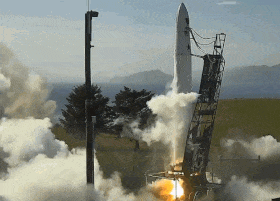The American company Astra launched the Rocket 3 light rocket for the third time, but again unsuccessfully: during the launch, one of the five engines of the first stage failed, so the flight began on a horizontal trajectory. Nevertheless, thanks to the remaining engines, the rocket was able to stabilize and rose several tens of kilometers, after which the company's specialists turned off the remaining engines and ended the mission. The launch was broadcast on YouTube.
Astra is developing a light two-stage rocket with kerosene-oxygen engines, capable of putting up to 150 kilograms into an orbit with a height of 500 kilometers. The company was founded in 2016 and two years later the company began testing its light rocket, being at that time in "hidden mode". In the first two flights, a mass-dimensional layout was used instead of the real second stage, so they were suborbital. Since 2020, the company has come out of the" hidden mode " and started orbital launches. The first of them was canceled, and the rocket was then lost due to an accident during pre-launch preparation. Two subsequent launches took place, but were unsuccessful, although during the last one the rocket managed to reach space.
During the new launch, which took place on August 29, the rocket carried a commercial payload for the US Space Forces for the first time. The launch took place at 01:45 Moscow time. Less than a second after the launch, one of the five engines shut down, so the rocket immediately tilted heavily, but after a couple of seconds it managed to return to an upright position. Due to the initial roll and reduced thrust, the rocket began to fly along an almost horizontal trajectory. Then the trajectory gradually straightened out and the rocket went into vertical flight.
Reviewing flight data and video, two things are very clear - 1) An engine shut down right after launch 2) Everything that happened next made me incredibly proud of our team. Space may be hard, but like this rocket, we are not giving up. #AdAstra pic.twitter.com/2g3n812EaW
— Chris Kemp (@Kemp) August 29, 2021
Since the rocket did not collapse and remained controllable, the specialists decided not to stop the flight in order to collect more data. After two and a half minutes, it rose to 31 kilometers and the engines turned off at the command from the flight control center. The maximum flight altitude was about 50 kilometers.
In May, the American company Rocket Lab faced an accident of an Electron light rocket for the second time in a year. The company's specialists found out the reason for the failure and successfully launched a new rocket two and a half months later.
In recent years, light launch vehicles have been gaining popularity all over the world, especially among private companies. For example, in 2019 and [...] 2020, two Chinese companies i-Space and Galactic Energy launched their light rockets, and in early 2021, the American-British Virgin Orbit successfully launched a LauncherOne rocket for the first time from under the wing of a Boeing 747 aircraft.
Grigory Kopiev

